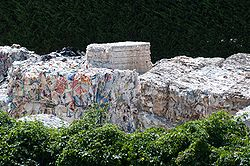The United States is the world’s leading producer of paper and paperboard, and produces on average about 700 pounds of paper per person. 300 million metric tons of paper and paperboard are produced around the world each year. Out of this, the US produces about 87 million tons per year, or one third of the world’s total.
In 2008, 34 million tons of paper were thrown away. Even so, paper makes up a third of all
recyclables in the US. The general composition of paper pulp is 33% from whole trees, 33% from woodchips and other scrap, and 33% from recycled paper. Unfortunately, every time paper is recycled, the fibers become shorter. After going through the recycling process 5-7 times, the fibers are too short to bind together into new paper. (Source)
After being taken to the recycling facility, the paper is shredded, mostly for security reasons. The shredded materials are placed into bales to await further processing. A typical paper recycling facility can expect 242 tons of paper or more every day. Often the paper materials are mixed with trash and so the shredded paper bales are mixed with water, and large non paper materials are left behind. To be thorough, the mixture is placed in a large machine where bubbles push contaminants to the top where they are skimmed off. Paperclips, plastic, and trash are the most common contaminants. From there the slurry is washed even more and then bleached.
After cleaning and bleaching, the slurry is poured onto a wire mesh frame. At this point the slurry mix is 99% water, and that must be reduced to 4.5%, so the wire mesh is important in draining water out of the mixture. It is from here that the materials are sent to the paper machine. Large rollers within the machine squeeze out water and smooth the surface. Heated rollers flash dry the paper, and it is then cut into huge rolls of solid paper.
For a more visual explanation, check out this video from WQOW News 18, Wisconsin.
By Alanna Scheinerman, Class of 2013


Hey thanks for posting the article. The video was great. I really enjoyed watching it! Those massive bricks really show you how much we need to recycle our paper or that goes in the landfill!